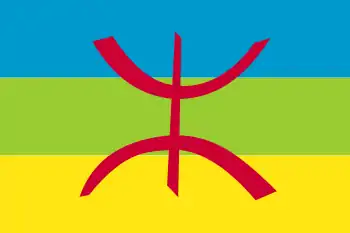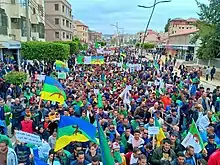Berber flag
The Berber flag (Berber language: Akenyal Amaziɣ, ⴰⴾⴻⵏⵢⴰⵍ ⴰⵎⴰⵣⵉⵗ) is a flag that has been adopted by many Berber populations including protestors, cultural and political activists. It is currently used by Berber political and cultural activists and organizations in 10 African countries, namely: Morocco, Algeria, Tunisia, Libya, Mauritania, Mali, Niger, Burkina Faso, Egypt and the Canary Islands.

The flag was inaugurated in Wadya, a town of Kabylia situated in Tizi Wezzu, a province of Algeria, by an elder Algerian Kabylian veteran, Youcef Medkour.[1]
History

In the 1970s, the Berber Academy (Agraw Imazighen) proposed the first Berber flag. In 1998, the World Amazigh Congress made the flag official at Tafira on Las Palmas in the Canary Islands, which were formerly inhabited by the Guanches, an ancient Berber people.
The flag is composed of blue, green, and yellow horizontal bands of the same height, and a Tifinagh letter yaz or aza.
Description
Each colour corresponds to an aspect of Tamazgha, the territory inhabited by the Berbers in North Africa:
- Blue represents the sea.
- Green represents the Tell and the north of Tamazgha.
- Yellow represents the vastness of the desert.
- The red of the letter Z (ⵣ in Tifinagh) represents the freedom of the Imazighen.
The Berber flag thus symbolizes the entire Amazigh people, living in harmony with their land, Tamazgha.
| Blue | Green | Yellow | |
|---|---|---|---|
| Pantone | 195c | RAL 1024 | RAL 1026 |
| CMYK | 100-25-0-20 | 25-0-75-20 | 0-10-93-0 |
| RGB | 0-153-204 | 153-204-51 | 255-229-19 |
| Hexadecimal | #0099CC | #99CC33 | #FFE513 |
References
- Yahia ARKAT (10 January 2019). "Aux origines de l'emblème amazigh" (in French).
